The Best Miso Substitute & Alternatives (+ the Worst)
Create a homemade miso substitute or explore more miso paste alternatives – from doenjang and fermented bean paste to soy sauce and coconut aminos. We also consider the replacements for miso paste you should use with caution.
Miso paste is ubiquitous in Japanese cuisine. And rightly so. It’s a delicious fermented soybean paste with a salty yet sweet, earthy, umami flavour.
It adds a unique flavour to many Japanese dishes. But there is no need to stress if you can’t find miso paste in the grocery store.
We gathered some of the best miso paste substitutes you may already have in your pantry – as well as those you should handle with caution. And our homemade miso substitute recipe allows you to play around with flavours until it suits your unique needs.
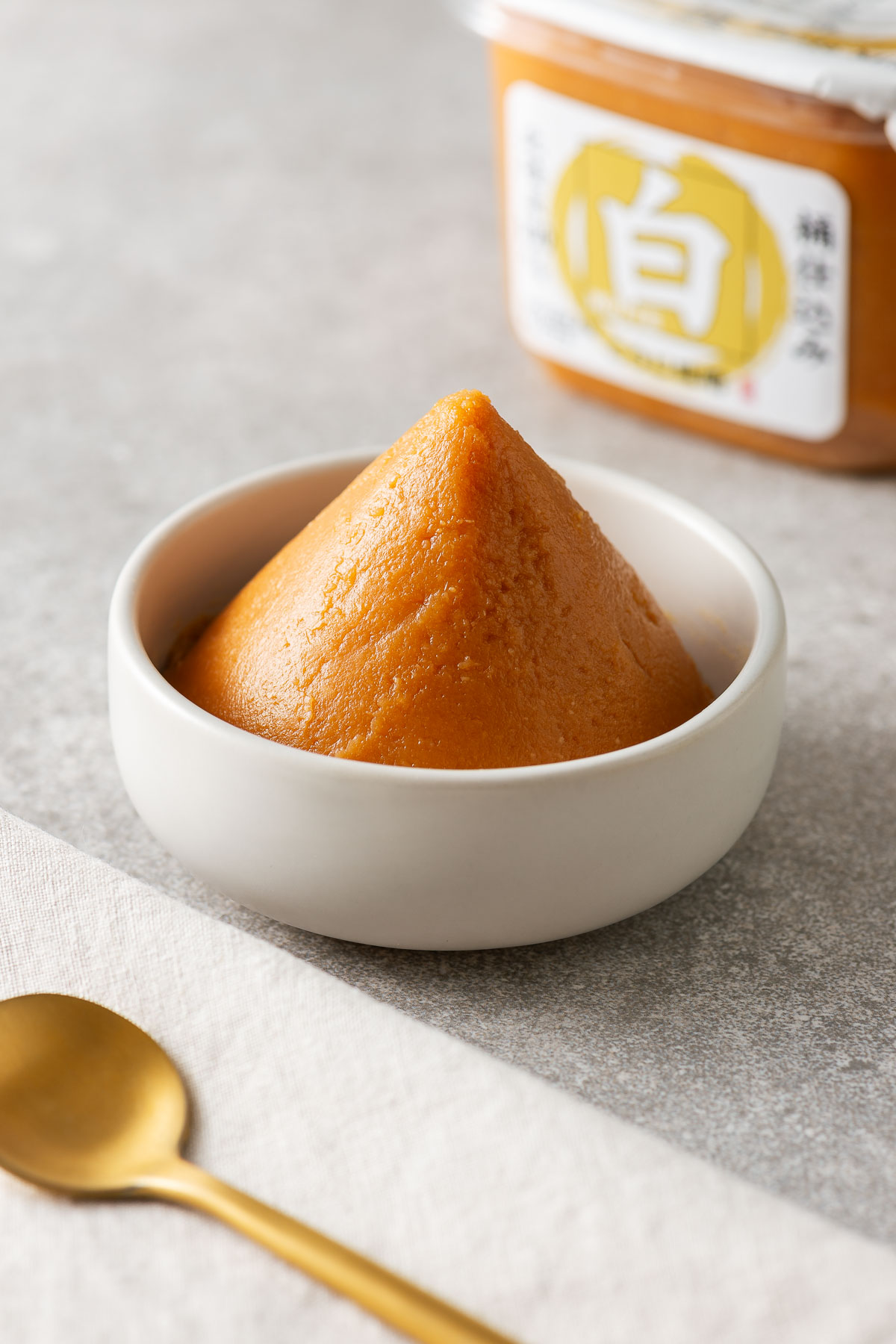
What is miso?
Miso is a traditional Japanese fermented soybean paste. In addition to soybeans, it always contains salt and some form of koji (which may include grains like rice or barley).
It has a salty, earthy, umami flavour that adds depth to any dish. And the lighter in colour the miso paste, the fruitier the flavour tends to be.
Miso is available in a variety of colours and textures, ranging from white (shiro miso) to red (aka miso) to dark brown (mugi miso). White miso paste is the mildest in flavour, while red miso is more intense and salty.
Miso is an essential ingredient in many Japanese dishes like miso soup, ramen, udon and soba noodle dishes.
Keep reading for more on miso paste ingredients and types, or jump straight to the list of miso substitutes.
Typical miso paste ingredients
The three essential ingredients for Japanese miso paste are soybeans, koji and salt. We all know soybeans thanks to the popularity of Asian ingredients like soy sauce and tofu.
But what is koji?
Koji refers to grains (typically rice or barley) or soybeans inoculated with the beneficial mould Aspergillus oryzae. The right temperature and humidity conditions encourage the growth of the mould. And it’s easy to innoculate grains using tane-koji (koji spores or koji starter).
Koji has a sweet and fruity flavour, almost apricot-like.
For miso paste, koji (rice koji, barley koji or soybean koji) is mixed with cooked soybeans and salt. Salt wards off harmful bacteria while allowing fermentation to take place.
The ratio of koji to soybeans determines how fruity vs savoury the resulting miso paste is. And the longer the fermentation time, the less fruity and more intensely savoury a miso paste becomes.
It is possible to ferment other starchy legumes in the same way. Chickpea miso (garbanzo bean miso) is available in some grocery stores. And I’ve successfully made “miso pastes” using dried butter beans, red lentils and yellow split peas. The latter is one of the miso recipes in The Noma Guide to Fermentation by David Zilber and René Redzepi – an excellent resource for avid fermenters.
Did I forget to mention I geek out about fermentation a bit?
Types of miso paste
There are several types of miso, but white and red miso are the most common miso pastes you’ll encounter in the grocery store aisles. Asian grocery stores will stock a wider variety.
Let’s look at some common miso types to illustrate the impact of fermentation time and koji-to-soybean ratios:
- White miso (shiro miso): This is the mildest variety. The fermentation period is short (two to eight weeks). And it has more rice koji than soybeans. It has a light colour and slightly sweet taste, making it ideal for dressings, marinades, and light miso soup.
- Yellow miso (shinshu miso): This miso gets fermented longer than shiro miso with a higher ratio of soybeans to koji. It is still fairly mild with a golden yellow colour. But it’s more savoury than white miso.
- Red miso (aka miso): Red miso ferments even longer – often more than a year. The flavour is intensely savoury and salty. And the colour changes to a deep red or black during fermentation thanks to the Maillard reaction. It’s excellent in hearty dishes like stews and braises.
- Mixed miso (awase miso): This is a combination of white and red miso, offering a balance of the milder white miso’s sweetness and the deeper flavour of red miso. It’s a great all-purpose miso paste to keep on hand.
Miso is also classified by ingredients. Mugi miso contains barley koji (and is therefore not gluten-free), whereas mame miso uses soybean koji and no grains. Hatcho miso is a special regional type of mame miso. And genmai miso uses brown rice koji instead of white.
The best substitutes for miso paste
Miso is a key ingredient in many dishes and sauces, but there is no need to fret if you’ve run out. Now that we understand the magical flavour of miso paste, we can find the best miso alternative to suit your needs.
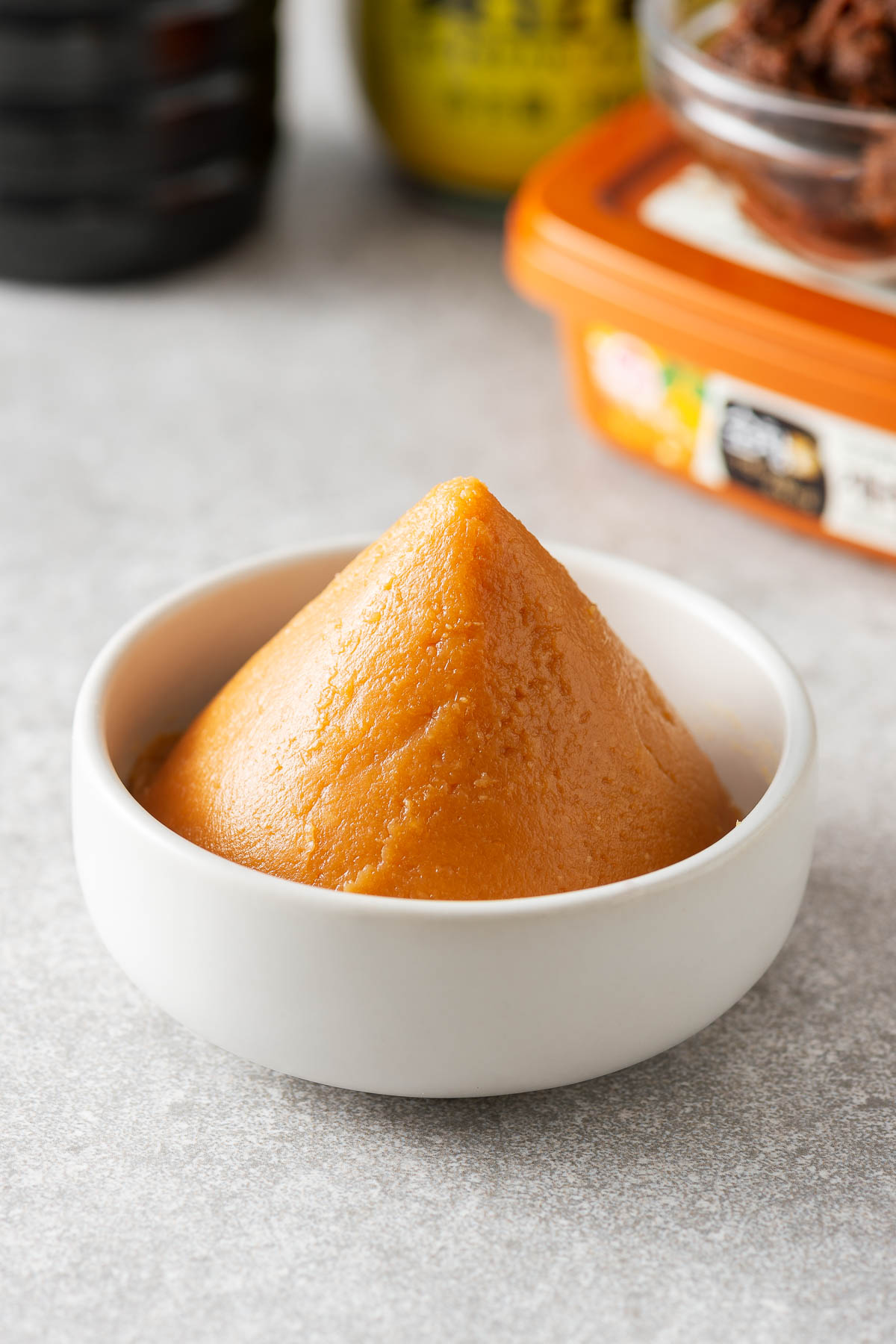
1. Homemade miso substitute
Miso paste has a salty, earthy, slightly sweet and fruity flavour with a fermented tang that truly adds a unique depth to soups, sauces and marinades.
Due to its complex flavour, finding the best miso paste substitute is a challenge – that I loved taking on.
And this homemade miso substitute recipe is more of a template to help you find the best miso alternative for your pantry, diet and recipe.
You will need a few pantry staples to make the best miso substitute:
- Soybean product for the salty umami flavour: A savoury fermented soybean paste, like doenjang, works best. But you can also use soy sauce or tamari. And if you are sensitive to soy, you can use coconut aminos.
- Seed or nut butter for earthiness: I prefer tahini here, but you can also use your preferred nut or seed butter. And if you’re making miso soup, you can leave the tahini. But it’s best to include the tahini in dressings and sauces.
- Mirin for sweetness: The Japanese rice wine is sweet and complex with some of the characteristic koji flavours we love in miso paste. But if you don’t have any, you can sweeten the mixture with maple syrup or honey.
Find the full recipe in the miso paste substitute recipe card with variations for white miso paste substitute or red miso paste substitute.
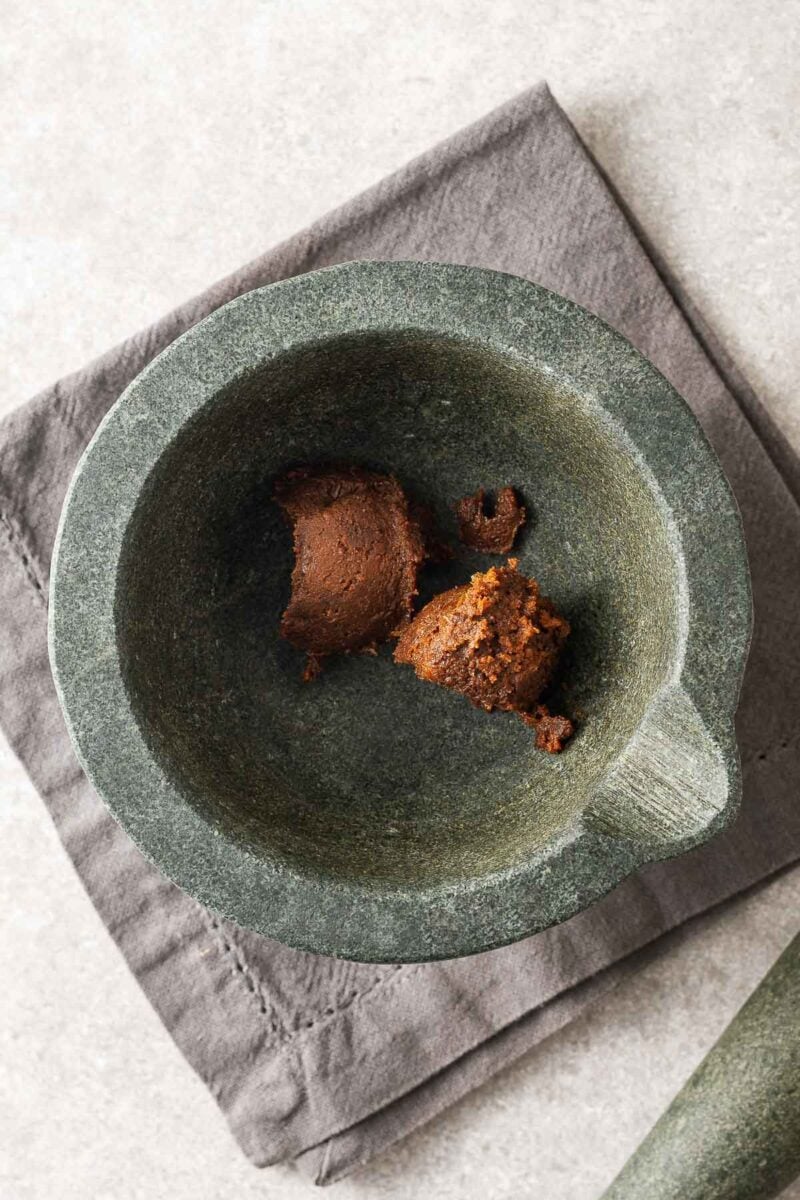

Store this miso substitute in a clean airtight container in the fridge for up to two weeks. Use clean utensils (not fingers) to remove the miso substitute from the jar as you would with miso paste.
Use it as a direct substitute for miso paste in sauces and dressing. And adjust the quantity to taste in miso soups and stews.
2. Soy sauce
Fermented soybean sauces like soy sauce, shoyu, and tamari make a great miso paste substitute because it’s so widely available. It has an umami-packed salty flavour that can replace miso’s savoury taste.
Shoyu is the catchall term for Japanese-style soy sauces made from fermented soybeans, wheat, salt and water. They are thin, clear and excellent all-purpose cooking and table sauces. Learn more about the difference between soy sauce and shoyu (from Kikkoman).
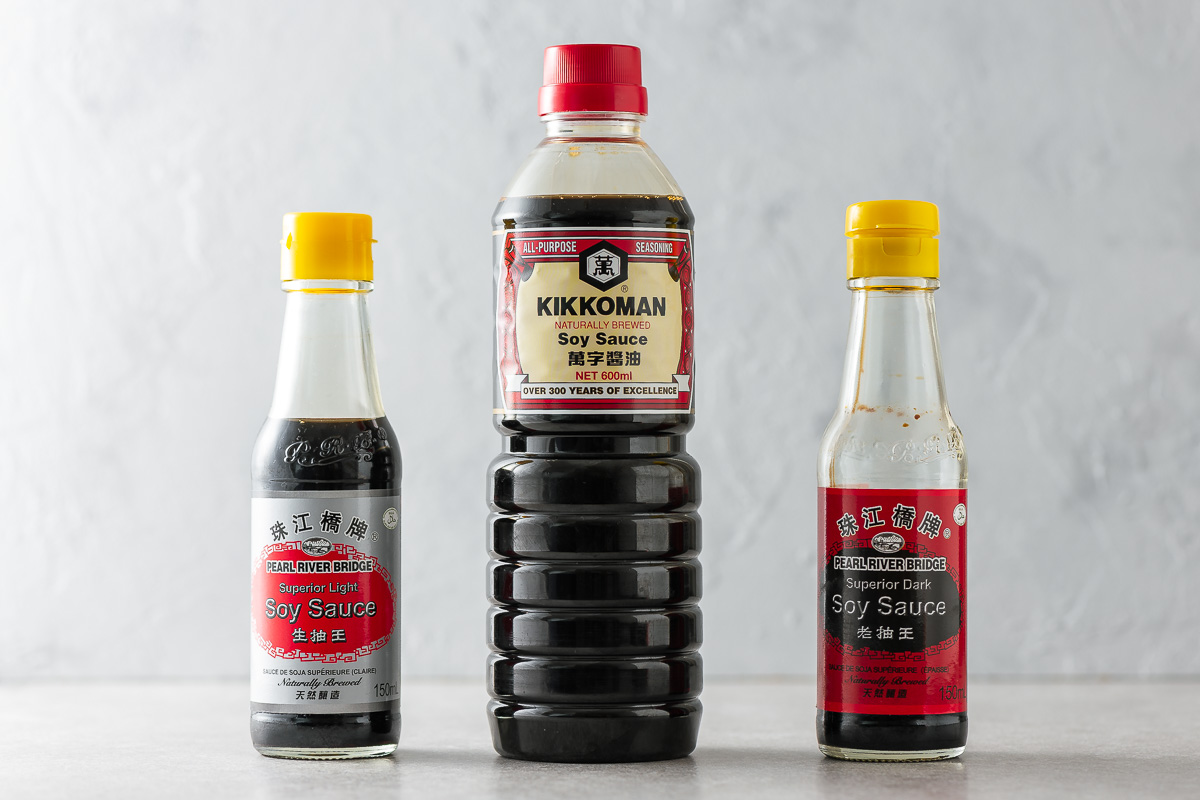
You can use soy sauce in soups, stews, and marinades to replace miso paste.
But it’s important to note that soy sauce is saltier than miso paste without any sweetness. And all-purpose or light soy sauce will work best – avoid dark soy sauce as a substitute for miso.
Start with half the amount of miso paste your recipe calls for and taste, adjusting the ratio of soy sauce to other ingredients until you’re happy with the result. And add a little bit of sweetness with a splash of mirin or maple syrup for the best flavour match.
3. Coconut aminos
This is a great naturally gluten-free and soy-free alternative to miso paste.
Coconut aminos is a sauce made from fermented coconut sap and sea salt. It is salty, umami-packed and slightly sweet with a similar flavour to soy sauce. But the flavour is milder and sweeter, making it a good miso paste substitute.
To replace miso, swap it one-to-one for coconut aminos. Taste and adjust the balance with maple syrup for sweetness and sea salt for savouriness.
4. Doenjang
Doenjang is a Korean fermented soybean paste. It is a common ingredient in soups, stews (like doenjang-jjigae) and dipping sauces (like ssamjang). Its culinary use in Korean cuisine is similar to miso paste in Japanese cooking. And it makes an excellent alternative to miso paste – with some minor adjustments.
It is a dark brown, thick paste with an umami-packed, salty flavour – much saltier with a stronger flavour compared to miso. And the texture tends to be coarser and thicker than miso paste.
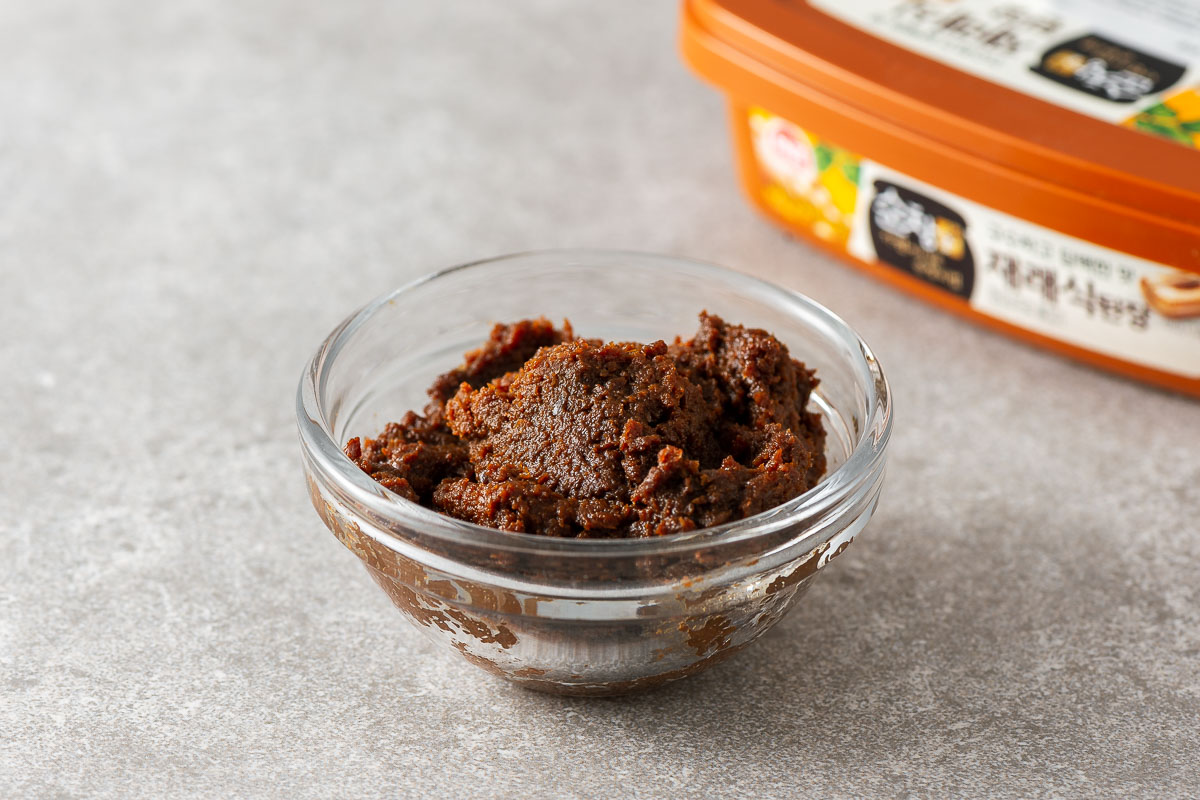
When you use doenjang as a miso paste replacement, there are a few things to keep in mind:
- doenjang is saltier and more intense,
- the texture is thicker and coarser,
- and the flavour is not as sweet and fruity.
You can use doenjang as a good substitute for miso: Blend or grind the doenjang until smooth – if you need a similar texture. Then start with half the amount of miso called for in the recipe. And adjust the seasoning in your recipe to account for doenjang’s saltiness.
For an even better miso replacement, add a splash of mirin or maple syrup to doenjang for a touch of sweetness – see the miso substitute recipe.
5. Chinese soybean paste
Dòubàn jiàng is a Chinese fermented soybean paste with regional differences. In Sichuan cooking, the paste is spicy (and called làdòubàn jiàng in some regions). In other parts of China, dòubàn jiàng can refer to a non-spicy fermented soybean paste. And in Southern China, Taiwan, and Hong Kong it refers to a sweet bean paste.
Then there is yellow soybean paste (huángdòu jiàng). And, not surprisingly, the paste is made from yellow soybeans left over from soy sauce making. The texture is saucy yet chunky.
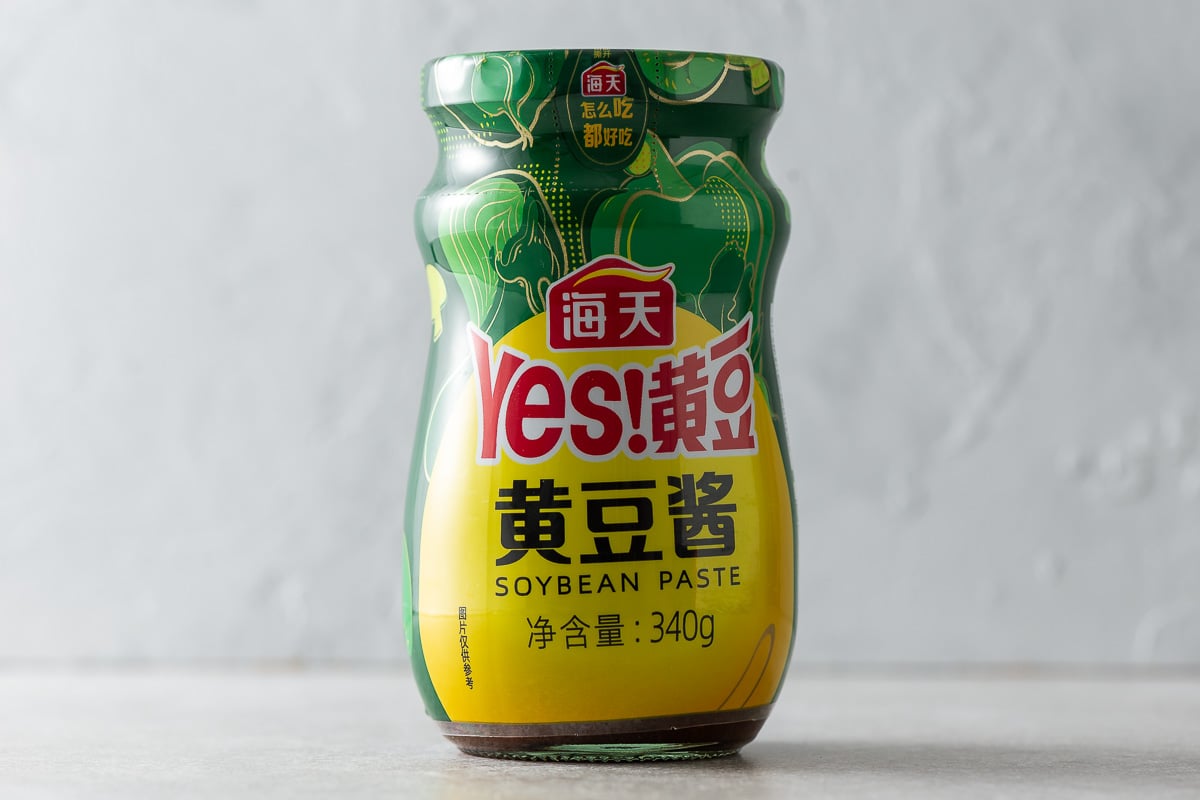
Confused yet? If you have Chinese soybean paste, it is best to look at the ingredient list and rely on your senses when substituting miso paste:
- If the paste is salty with an umami flavour reminiscent of soy sauce, use it as a 1:1 substitute and add a splash of sweetness.
- If the paste is sweet, start with half the amount and add extra salt.
- If the paste is spicy, use it as a direct replacement and enjoy the added spicy kick in your final dish.
- And if the paste is chunky, grind it into a smooth paste.
I found this guide to Chinese sauces and condiments very helpful in demystifying Chinese fermented soybean paste (via LTL Language School).
6. Marmite
Marmite (like Vegemite) is a yeast extract with a unique flavour and an intense, salty taste.
The thick and dark brown syrupy paste is best known as a spread. But it also adds an umami-rich, savoury flavour to soups, stews, marinades and sauces.
I’m not saying you should rush to the shop to buy marmite to substitute miso paste – there are better alternatives higher on the list. But, if you have no other deliciously salty umami-packed ingredient, marmite makes an adequate substitute in soups, stews and sauces to deliver a salty umami finish.
As of 2016, marmite is no longer classified as gluten-free. But it is a soy-free, unfermented, plant-based alternative to miso.
Besides, if you don’t already have marmite in the pantry, you will most likely not enjoy having it there! It really is that divisive.
When you use marmite as a miso substitute, start with half the amount and add more to taste. You may also want to add a bit of sugar (or even better, mirin) to balance the intense saltiness.
7. Salt
When all else fails, there is salt. While salt will never provide the same depth, it is a big flavour component in miso paste.
And salt may not be a particularly exciting ingredient, but it’s not going to drastically change the flavour profile of your dish like some of the worst miso substitutes out there.
Start with a quarter teaspoon of salt to replace every teaspoon of miso paste. Then taste and adjust accordingly.
Worst miso substitutes (and not-so-great ones)
There are quite a few odd miso substitute recommendations out there. But, ultimately, it’s a matter of taste preference and the dish you have in mind. So, take caution when you try the following condiments as miso substitutes.
Tahini or sesame paste
Tahini and Chinese sesame paste are both made from ground sesame seeds. Both have an earthy flavour, but sesame paste is significantly nuttier. See more differences between tahini and sesame paste.
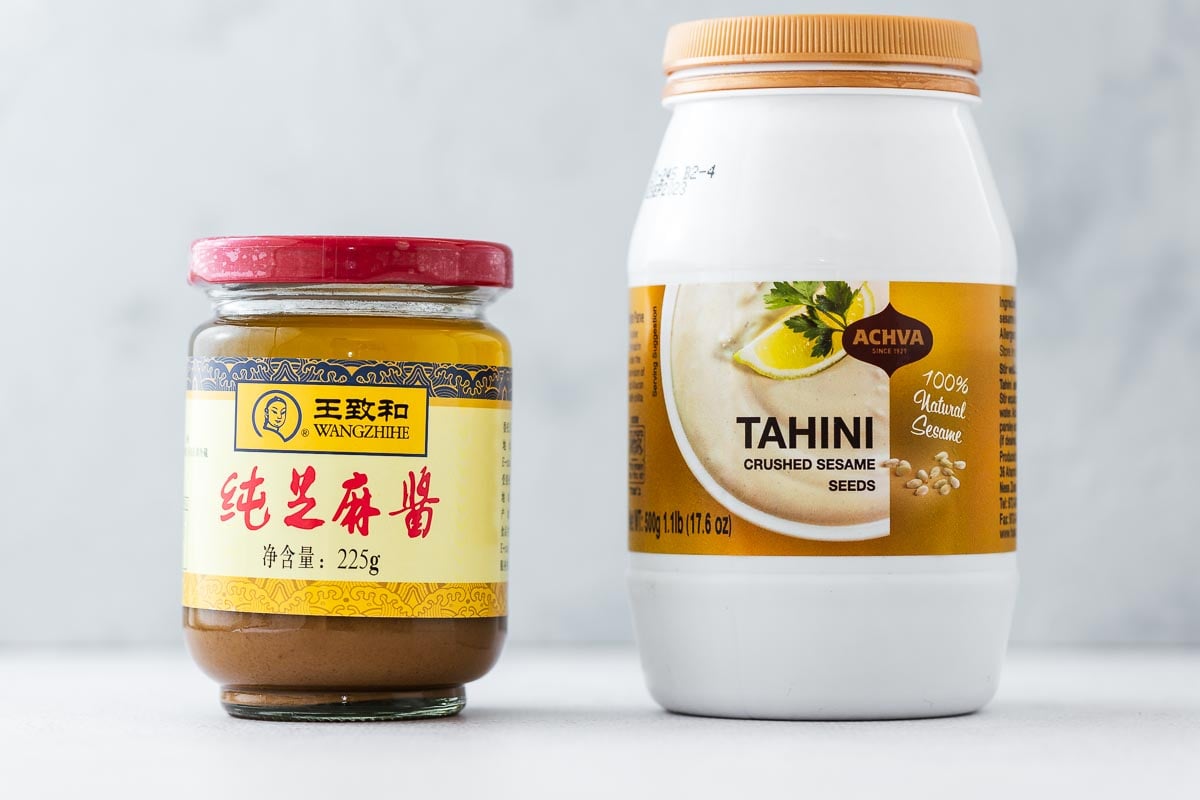
While delicious, both pastes lack the complex fermented umami flavour of miso. You can use either paste instead of miso paste in noodles or dipping sauces for a deliciously creamy and nutty result.
But it won’t come close to miso flavour unless you also add one of the best miso substitutes higher in this list.
Fish sauce or anchovy paste
Miso paste is not fishy.
Fish sauce is made from fermented fish – it’s a common ingredient in Southeast Asian cuisine. Anchovy paste is a spreadable paste made from fish. They’re both very fishy in flavour.
So, unless you’re making a seafood soup, the pungent fishiness of fish sauce and anchovy paste will drastically change the flavour profile of your dish.
But if you’re after salty, fishy, umami sauce, you can use fish sauce or anchovy paste instead of miso. You might just love the twist.
Dashi
Dashi is a delicious Japanese soup stock made from kelp and bonito flakes. It’s a clear broth with a subtle umami flavour that’s only slightly fishy.
Miso soup combines dashi broth and miso paste with spectacular results – there’s a reason why the Japanese soup is so popular! But substituting more dashi won’t make up for the lack of miso paste. Instead, add a splash of soy sauce and a dash of mirin to your dashi.
Tomato paste
I’m still trying to wrap my head around this often-recommended miso paste alternative. Sure, tomato paste is a paste, and so is miso. And they both have umami components. But the flavour is just so different.
Tomato paste is acidic and very tomato-y. It will impart a totally different flavour and red hue to your dish. Even red miso paste is not really all that intensely red.
If you’re out to create something new and push the cultural flavour boundaries, go ahead and use tomato paste instead of miso. But the resulting dish will be drastically different – though not necessarily unappetising.
But tomato paste caramel just does not have the same ring to it as miso caramel. Or maybe that’s just me?
How to use miso paste
Miso paste is a flavourful and versatile ingredient that can elevate your dishes with its rich umami flavour and complex taste. The Japanese fermented soybean paste adds umami, saltiness, and a unique depth of flavour.
If you’re curious about how to use miso paste, or you’re looking for some dishes to try your miso substitute in, here are some creative suggestions:
- Create umami-packed soups: Miso soup is a classic way to enjoy the depth of miso paste. Combine miso with dashi broth, tofu, seaweed, and vegetables to create a comforting and nourishing soup.
- Whip up marinades and glazes: Miso paste makes a fantastic base for marinades and glazes for meats, fish, and even vegetables. Try this all-purpose miso sauce.
- Elevate dressings and sauces: Incorporate miso paste into your salad dressings and dipping sauces for an extra layer of flavour. Try a creamy miso tahini dressing for your next kale salad or slaw.
- Add umami to rice and grains: Mix a spoonful of miso paste into cooked rice, quinoa, or other grains to infuse them with a savoury umami taste. This simple addition turns a plain side dish into a standout element of your meal.
- Experiment with miso in baking: Miso might be an unexpected addition to sweet treats, but its depth can work wonders. Incorporate a small amount of miso paste into cookies or brownies for a subtle, nuanced flavour that surprises and delights. Or try a miso caramel sauce to add Japanese flavours to your next dessert.
- Make miso butter: Create miso-infused butter by mixing softened butter with miso paste. Spread it on bread, melt it over grilled vegetables, or use it to sauté mushrooms for a rich and flavourful twist. Try this easy miso butter recipe.
Frequently asked questions
Miso has a unique rich flavour. It’s salty and umami-packed with sweet, fruity and earthy flavours. Soy sauce has the same salty umami flavour but lacks the sweet, fruity flavour. Add a splash of mirin for a closer flavour match.
If you don’t use soy-based products, you can use coconut aminos with a splash of soy-free mirin. Or try a small amount of marmite mixed with sesame paste and a pinch of sugar.
There is no exact Chinese equivalent of miso. But there are fermented soybean pastes, like dòubàn jiàng (fermented soybean paste) and huángdòu jiàng (yellow soybean paste). These pastes don’t have the sweet, fruity flavour of miso because they don’t contain koji.
Miso paste is a fermented soybean paste made from soybeans, sea salt, koji, and water. Koji is a grain (typically rice or barley) or soybeans inoculated with the beneficial mould Aspergillus oryzae.
Miso paste is a versatile ingredient. Mix it with dashi for a soup or stew base. Or add sake, mirin and sugar for an all-purpose miso sauce. Use it to marinate meats, glaze vegetables or make miso sauce for noodles or stir-fries.
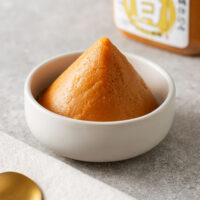
Ingredients
- 2 tablespoons doenjang , or another savoury fermented soybean paste, or soy sauce*
- 1 to 2 tablespoons tahini , or nut butter (optional)*
- 2 to 3 teaspoons mirin
- ¼ teaspoon salt , or to taste
Instructions
- If you're using a coarse fermented soybean paste (like doenjang), place it in a mortar and pestle and grind it into a smooth paste. If you're using a smooth soybean paste or soy sauce, add it to a small bowl.
- Then mix in 1 tablespoon of tahini if you want a red miso substitute or 2 tablespoons for a white miso substitute.
- Finally, stir in 2 teaspoons of mirin for a red miso substitute or 3 teaspoons for a white miso substitute – the mirin sweetens the paste. And then add the salt – or salt your final dish to taste.
- Refrigerate this miso substitute in a clean airtight container for up to 2 weeks.
Notes
- Korean doenjang is a fermented soybean paste. The texture is coarser than miso paste, and the flavour is intensely savoury. See homemade miso substitute for more ingredient details and alternative ideas.
- You can also use soy sauce in this recipe instead of soybean paste. It will make an excellent miso substitute flavour-wise, but the texture will be thinner.
- If you need a miso paste substitute for soups and stews, you can leave out the tahini. But it’s best to add tahini or nut butter if you’re making a miso paste for sauces and dressings to match the miso consistency.
- See the full blog post for the best miso substitutes to suit your pantry.
Love miso paste as much as I do?
You may also like these Asian-inspired recipes:
